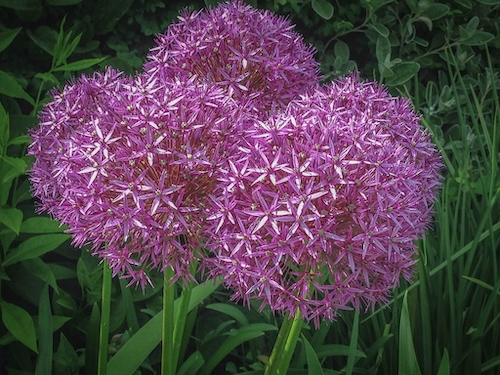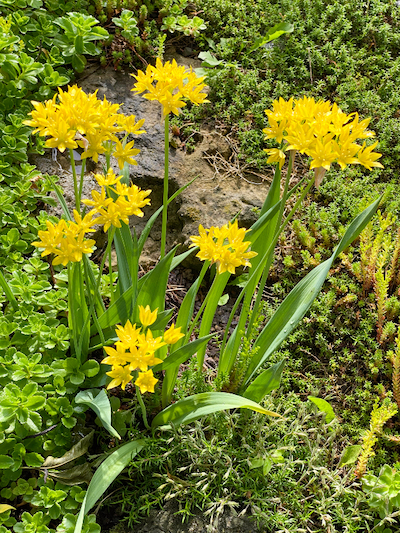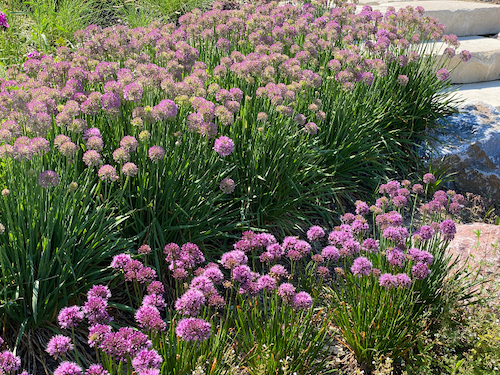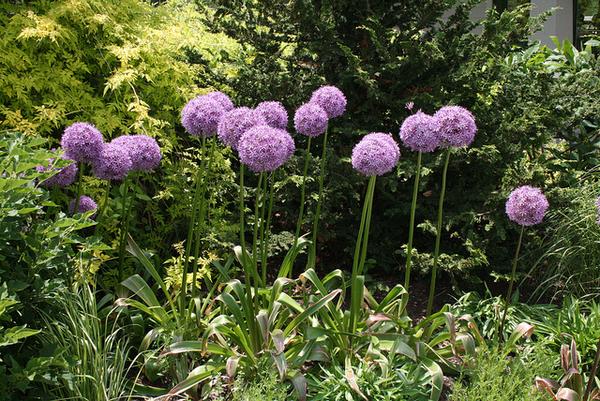Alliums — Nature’s Summer Fireworks

Allium giganteum flowers
by Janet Scheren, Fairfax Master Gardener
The song about the lonely little petunia in the onion patch doesn’t begin to do justice to the splendor of ornamental onions in the garden. While even the eating kind of onions can provide architectural interest, ornamental onions are striking standouts that can infuse your garden with whimsical interest or bold color from late spring well into late summer depending on the varieties selected. They also benefit the environment, attracting pollinators such as bees and butterflies.
Ornamental onions are part of the Allium genus, which includes onions, garlic, leeks and chives. As you might suspect from looking at their bulbs, they are distant cousins to daffodils and snowdrops.
While there are hundreds of Allium species, all are characterized by round flower heads with numerous tiny florets and tall, slender stalks. The flowers range from purple, pink, white to yellow and even blue, depending on the species and cultivar.
Allium giganteum, one of the tallest and most dramatic alliums, can reach heights of up to 6 feet (2 m). Its large, globe-shaped flower heads sprawl up to 6 inches in diameter. This species blooms from late spring to early summer and makes an excellent focal point in any garden.
Allium cristophii, also known as the ‘Star of Persia,’ features large, star-shaped, metallic purple flowers that form a loose, spherical head up to 10 inches in diameter. This species typically grows to about 1 to 2 feet tall and blooms in late spring to early summer. It is well-suited to rock gardens and mixed borders.

Yellow Allium molly
Allium cernuum, known as the ‘Nodding Onion,’ is a North American native species producing drooping umbels of pink to lavender flowers. This species typically grows 8 to 18 inches tall and blooms in mid to late summer. It is well-suited to rock gardens, wildflower gardens and naturalized areas.
Allium moly, or golden garlic, is a smaller species that typically grows to about 12 inches (30 cm) tall. It produces bright yellow, star-shaped flowers in dense clusters. This species blooms in late spring to early summer and is ideal for rock gardens, borders and naturalized areas.
Allium gladiator is big and bold. These huge blossoms, which are about the size of a softball, sit atop straight, sturdy stems that can reach 5 feet (1.5 m) in height. They have a long bloom time showcasing tight orbs of soft lavender flowers.
Allium aflatunense or ‘Purple Sensation’ is a typical all-purpose variety. The flowers rise 2 to 3 feet (0.5 to 1 m) and have perfect orbs. Best of all, this variety is one of the easiest ones to find in your local garden center in the fall. They are a darker purple color and mix well with larger varieties such as ‘Gladiator’ and ‘Globemaster.’ And because they are less expensive than larger varieties, they are a great way to add a lot of alliums to your garden.

Allium stipitatum
Allium stipitatum or ‘Mount Everest’ is a white variety set on tall stems with small orbs of creamy white flowers. Mix them in with other purple varieties to add a bit of depth and dimension to your garden. They also make a great filler in a bouquet. Try them mixed in a 5:3 ratio with some huge blossom alliums.
Allium schubertii or ‘Schubertii’ is my personal favorite — a perfect allium for the Fourth of July. Their star-like florets of different lengths make them look like fireworks exploding. They also are stunning dried — alone or in a dried floral arrangement. The floret is burgundy-purple with a small orb of small, loose flowers. While they have huge blooms, which can exceed 12 inches in diameter, they are among the shorter alliums standing only 12 to 18 inches (30 to 45 cm) tall.

Allium schoenoprasum
Growing Requirements
Alliums are relatively easy to grow and care for, provided they are planted in suitable conditions. They thrive in well-drained soil. Heavy clay soils should be amended with organic matter or sand to improve drainage. Sandy and loamy soils are generally ideal. Water the bulbs thoroughly after planting. During the growing season, provide moderate watering, allowing the soil to dry out between waterings. Overwatering should be avoided, as it can lead to bulb rot.
Alliums generally do not require heavy fertilization. A balanced, slow-release fertilizer can be applied in early spring to support growth and blooming. Avoid high-nitrogen fertilizers, which can promote excessive leaf growth at the expense of flowers.
Maintenance and Propagation
Alliums are low-maintenance plants that require minimal care once established.
Remove spent flower heads to prevent self-seeding and to maintain a tidy appearance. This practice also encourages the plant to focus energy on bulb growth rather than seed production.
Alliums can be propagated by division. Dig up and divide the bulbs every three to four years in early spring or fall to prevent overcrowding and to rejuvenate the plants. Each offset bulb should have roots and a portion of the basal plate. They can also propagate by self-seeding.
Alliums are generally resistant to pests and diseases. However, they can occasionally suffer from issues such as onion thrips, bulb mites, and fungal diseases, such as downy mildew or white rot. Proper spacing and good air circulation help minimize these problems.

Grouping of Alliums in the landscape
Landscaping Uses
Ornamental onions are versatile plants that can be used in a variety of garden settings to add height, structure and color. They make excellent border plants due to their tall, upright growth habit and striking flower heads. Smaller species are ideal for edging pathways and garden beds. Some, such as A. cristophii and A. cernuum, are well-suited to rock gardens, where their unique flowers and foliage can be showcased against a backdrop of stones and gravel. Their drought tolerance makes them particularly suitable for these conditions.
Many alliums are excellent choices for pollinator gardens. Their flowers attract bees, butterflies and other beneficial insects. Planting alliums in groups can create a visually stunning display while providing a valuable food source for pollinators.
Seasonal Interest
Alliums offer interest throughout the growing season. Early-blooming species like A. moly provide color in late spring, while late-blooming varieties like A. cernuum extend the display into late summer. The dried seed heads of many alliums can also add architectural interest to the garden in the fall and winter.
Prolific author and Danish horticulturist Claus Dalby shares alliums in his garden, including ‘Purple Sensation,’ ‘Globemaster,’ ‘Mount Everest’ and ‘Ravenswing’ at the YouTube link below.
- References
- Would you like to know about Alliums in my garden and how I plant them? Claus Darby, Danish horticulturist, You Tube video
- Allium, North Carolina State Extension
- Grow A Bloomin’ Onion, Ray Novitske, Fairfax Gardening
- Nodding Onion, Allium cernuum, Wisconsin Horticulture, University of Wisconsin Madison
- Allium cristophii , North Carolina State Extension
- Giant Allium, Home Gardening Growing Guide, Cornell University